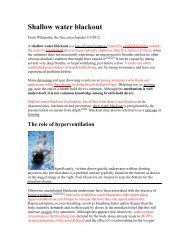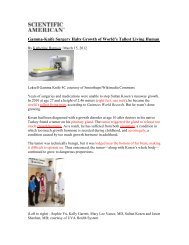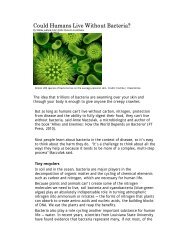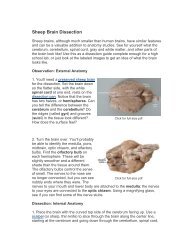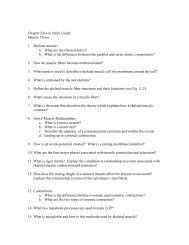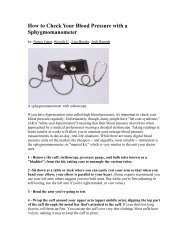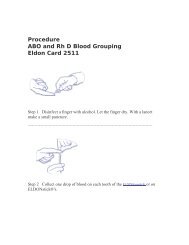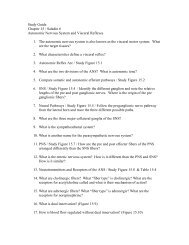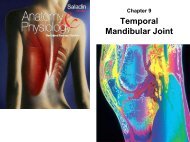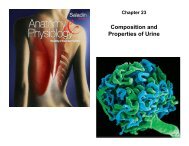Chapter 24 Study Guide Water, Electrolyte, and Acid-Base Balance ...
Chapter 24 Study Guide Water, Electrolyte, and Acid-Base Balance ...
Chapter 24 Study Guide Water, Electrolyte, and Acid-Base Balance ...
- No tags were found...
Create successful ePaper yourself
Turn your PDF publications into a flip-book with our unique Google optimized e-Paper software.
<strong>Chapter</strong> <strong>24</strong> <strong>Study</strong> <strong>Guide</strong><br />
<strong>Water</strong>, <strong>Electrolyte</strong>, <strong>and</strong> <strong>Acid</strong>-<strong>Base</strong> <strong>Balance</strong><br />
1. What three homeostatic mechanisms regulate the cellular fluid medium?<br />
2. Fluid compartments:<br />
a. What are the two principle water compartments in the human body? (<br />
b. How are the non-cellular volumes further subdivided?<br />
c. Describe how water moves between these compartments:<br />
3. <strong>Water</strong> gain <strong>and</strong> water loss:<br />
a. What is water balance?<br />
b. What terms describe gain <strong>and</strong> loss?<br />
4. Regulation of intake:<br />
a. Where is the thirst center located?<br />
b. What is the three stimuli signal dehydration?<br />
4. <strong>Water</strong> balance disorders:<br />
a. What are the two kinds of water deficiency <strong>and</strong> how do they differ?<br />
b. What are the fluid excesses?<br />
5. What is fluid sequestration <strong>and</strong> give examples?<br />
6. <strong>Electrolyte</strong> <strong>Balance</strong>:<br />
a. What are the major cations <strong>and</strong> anions?<br />
b. Describe the homeostatic mechanisms regulating these ions:<br />
7. <strong>Acid</strong>-<strong>Base</strong> <strong>Balance</strong><br />
a. What is the difference between a strong acid <strong>and</strong> a weak acid (give<br />
examples)?<br />
b. What is the difference between a strong base <strong>and</strong> a weak base (give<br />
examples)?<br />
c. What is a buffer?<br />
d. What is the difference between a physiological buffer <strong>and</strong> a chemical buffer?<br />
e. What are the three major chemical buffer systems <strong>and</strong> explain how they work?
8. Disorders of acid-base balance:<br />
a. Define acidosis <strong>and</strong> alkalosis: (less than 7.35 or greater than 7.45)<br />
b. How is the electrical potential across the plasma membrane changed by<br />
acidosis <strong>and</strong> alkalosis?<br />
c. What is the difference between respiratory acidosis <strong>and</strong> respiratory alkalosis?<br />
d. What is the difference between metabolic acidosis <strong>and</strong> metabolic alkalosis?<br />
9. Compensation for <strong>Acid</strong>-<strong>Base</strong> Imbalances<br />
a. How is acidosis <strong>and</strong> alkalosis compensated for in the body?<br />
b. Which form of correction is more effective?



